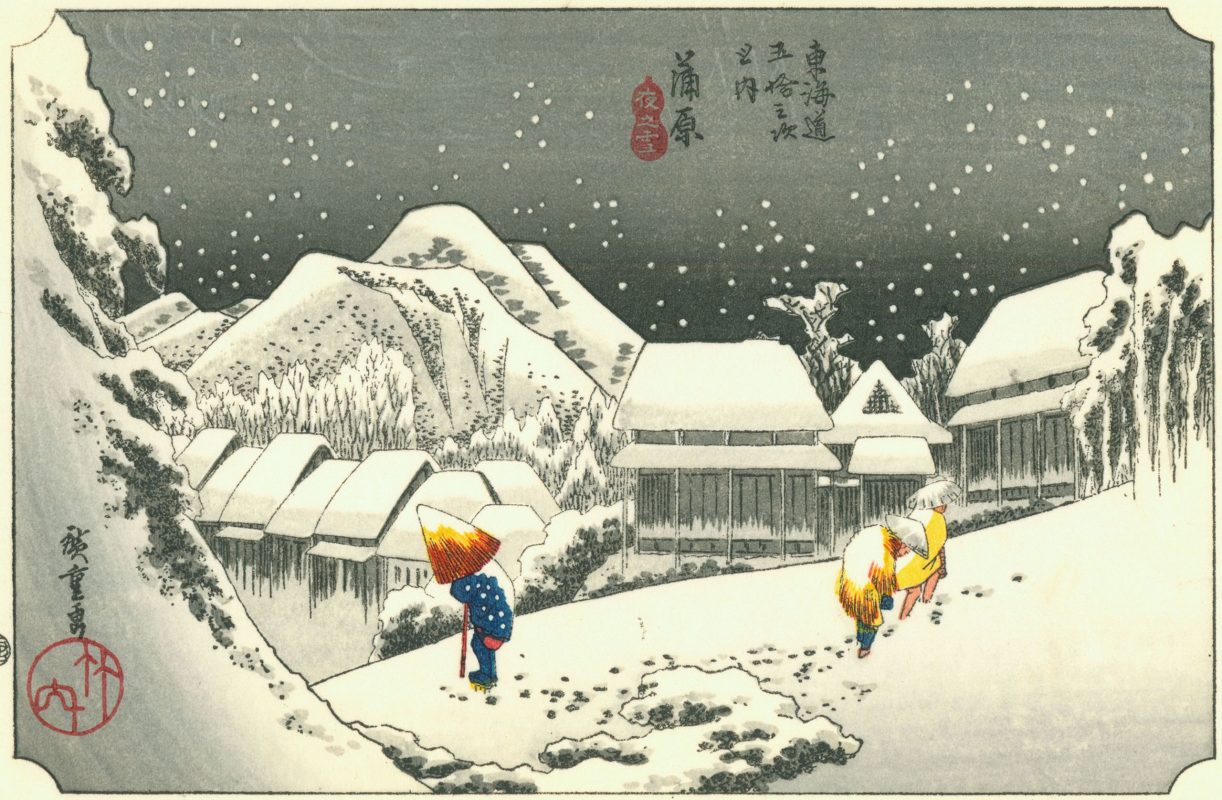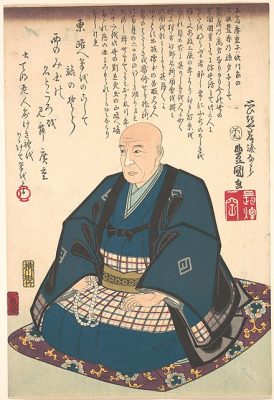Japanese Artists
Utagawa Hiroshige Artwork, Paintings and Prints
Hiroshige can be considered amongst the finest landscape artists in history, as well as someone who helped to further advance the techniques of Japanese woodblock printing. He arrived towards the end of the ukiyo-e era and took influence from the likes of Hokusai.
Japanese artists would often have to tailor their output to the norms of society, with some depictions of social activities of the urban elite being considered unacceptable on occasion. Hiroshige tended to avoid any such controveries by working almost exclusively on nature-based themes. Other braver artists would even sometimes mimic local politicians in a form of satire, but our artist here was more in tune with nature and just generally prefered to work with these topics. Where human figures can be found within some of his paintings, they would tend to be placed within a sprawling landscape and would play more of a supporting role. Most touches of humanity were kept to a minimum or perhaps carefully blended in with a subtle touch of the brush, for example with the use of boats or bridges rather than great expanses of city dwellings.
The ukiyo-e period lasted for several centuries and encompassed a good variety of styles. Some artists involved would concentrate on obtaining good income by selling printed reproductions of their designs. This encouraged the development of more commercially-viable production processes but Hiroshige himself was always someone who did not want to sacrifice his artistic integrity for the purposes of greater profit. He would use the more labour-intensive processes if he deemed the output from it to be superior. He was perhaps old-school in that regard, but was also technically innovative and an important contributor to this critical era in Japanese art history. It was his gradients of colour which helped to add interest to large expanses of sea or sky which remains one of his signature touches and can be found in most of his famous artworks.
This was an artist who entirely understood the beauty of the Japanese countryside and would spent most of his life producing stunning depictions of it. Many of the elements of what we consider to be Japanese art can be found here, with pretty flowers, imposing mountains and intelligent garden design all here. The addition of small fishing boats and age-old wooden bridges also help to create this atmosphere of the charming Japanese culture that continues to be so popular around the world, particularly in the west. One of the symbols of his importance is in how the ukiyo-e movement would drift into the background after his passing, having been the cornerstone of this nation’s artistic output for several centuries. Thankfully, knowledge of his career is as strong today as it ever has been and plenty of documentation around his career has now been translated into most major languages, allowing us all to understand him better.
Those in western cultures have become aware of Hiroshige initially because of his connection to western art, where he helped to inspire some of the finest painters from that region during the 19th century. Many are aware of how Vincent van Gogh even produced two painted copies which provided his own take on Hiroshige’s One Hundred Famous Views of Edo: Plum Park in Kameido and Sudden Shower over Shin-Ōhashi bridge and Atake, which are two of the Japanese artist’s most famous designs. Although Van Gogh would take things in a new direction within his own post-impressionist style, the respect and admiration was clear. Manet and Monet would also collect his prints and also found the methods of composition to be highly innovative and challenged the traditional ideas of European artists. For example, it became acceptable to crop scenes more aggressively in a similar way to how photography had started to encourage.
The artist himself would sadly lose his parents whilst a teenager and it is perhaps this event which caused him to start painting for the first time. The focus on art may have been a way of distracting his mind from tragedy and instead providing an inner calm, and it would certainly not be the first example of that (even Van Gogh himself was tormented for much of his life by his own turbulent mind). He was eventually accepted into an art school and from that point onwards could learn the intricate techniques of Japanese art. Having lived under several different names in his short lifetime already, he appeared to have settled on Hiroshige by this point, as shown in the signatures that he would now add to his completed artworks. Previous incarnations included the likes of Jūemon, Tokubē, and Tetsuzō, with most famous Japanese artists having altered their official name from time to time.

Whilst nature would become his signature genre, it would actually be many years before he focused almost entirely on this theme. Prior to that were his formative years where he is believed to have studied a number of different Japanese schools of art, such as Chinese Southern School, the Kanō School and the Shijō School. He would also have learnt about the techniques of European art, with perspective being a particularly intriguing element to that. The late Renaissance brought about an interest in avoiding flattening imagery with Italy and Northern Europe, and so by the time that Hiroshige looked into it in the early 19th century, the discipline would have developed much further. Architecture would play a significant role within art from both regions of the world, and there were many different methods of interpreting it on paper or canvas. Most famous artists have been engulfed with a wealth of knowledge from an early age and have needed time in order to process it all and then start to develop their own favoured approach.
Hiroshige would establish himself as a respected artists during the 1830s and then cement that position further over the next two decades. He continued to read as much as possible in order to make his paintings as detailed and accurate as possible as he was not always able to travel to the locations in person. He would even require financial help from time to time in order to continue to complete some of his more ambitious projects. One way of supplementing his income was to then provide teaching services to younger artists, which he did successfully. This was the normal passage taken in Japanese art at the time, where technical skills would be passed on through art schools or private tutoring. Students would sometimes take the names of their teachers as a sign of respect and would be known as the next in this lineal path. Hiroshige would achieve a better financial position in later life but much of his work failed to live up to the standards of his earlier creations, or at least that is from the point of view of many art academics who have studied his career in detail.
It is hard to quite comprehend the output levels of this artist, with Hiroshige believed to have produced around 8,000 works in total by the time of his passing in 1858. His pre-1830 paintings are not treated with the same level of passion as that which followed on afterwards and was seen as merely following what had gone before from other artists. Most academics tend to summarise his highlights into the main series of paintings that captured different scenes of the Japanese countryside. Many other artworks outside of those were sadly lost or destroyed, so it would be entirely wrong to believe that thousands of his designs still exist today, or are even accurately documented. The biggest impact that he made, and something that continues to be taught to art students today, is how he advanced the very nature of woodblock printing and helped to achieve more complex results which gave the ukiyo-e era one last high before it finally drifted off into the realms of history.
